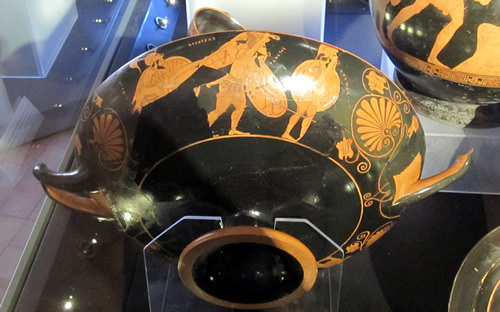 Once shattered, on display for first time in 20 years
Once shattered, on display for first time in 20 years
The oldest known vase by the Leonardo da Vinci of ancient Greece has emerged from hiding after two decades. Last seen in public at a June 1990 auction at Sotheby’s in New York, Euphronios’ Sarpedon kylix has gone on display at Rome’s Villa Giulia museum with no fanfare or public announcement. Making the appearance more significant, the cup has been repaired—fixing the damage done when a Swiss police officer dropped it during an inventory of antiquities seized from dealer Giacomo Medici at the Geneva Freeport in 1995. The “lost chalice” now shares a glass case with a handful of other vases in a room dedicated to artifacts returned to Italy by American museums and collectors. Its label, which has no accession number, describes it as coming from the Geneva raid (and doesn’t mention that, technically, it’s still Medici’s property, pending the resolution of his legal cases).
The cup is in good company: the case next to it holds another rare, signed Euphronios, a fragmentary krater depicting Athena that was sold at the same auction and later given to Italy by collector Shelby White. The repaired kylix has been on display since at least May (when I first spotted it there) and I’ve been waiting to see if there’d be any announcement before posting on it. As this is the biggest development in Greek pots for 2010, New Year’s Eve seemed like a good time. What remains to be seen is if it will ever get displayed alongside its bigger twin, the Met’s former “Euphronios Krater.” That vase, which depicts the same scene, is also at Villa Giulia, in a separate wing.